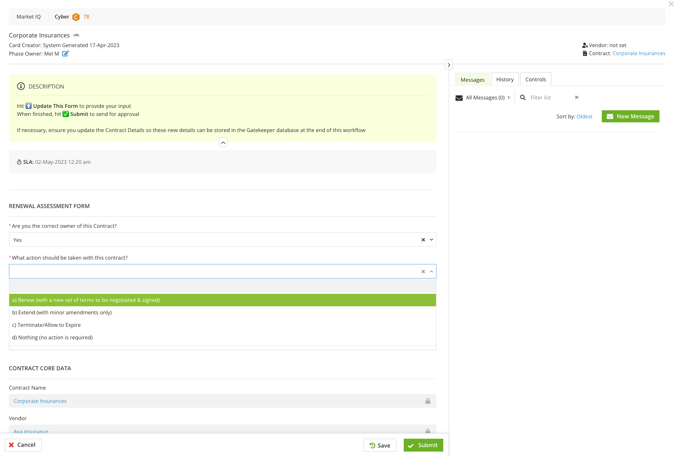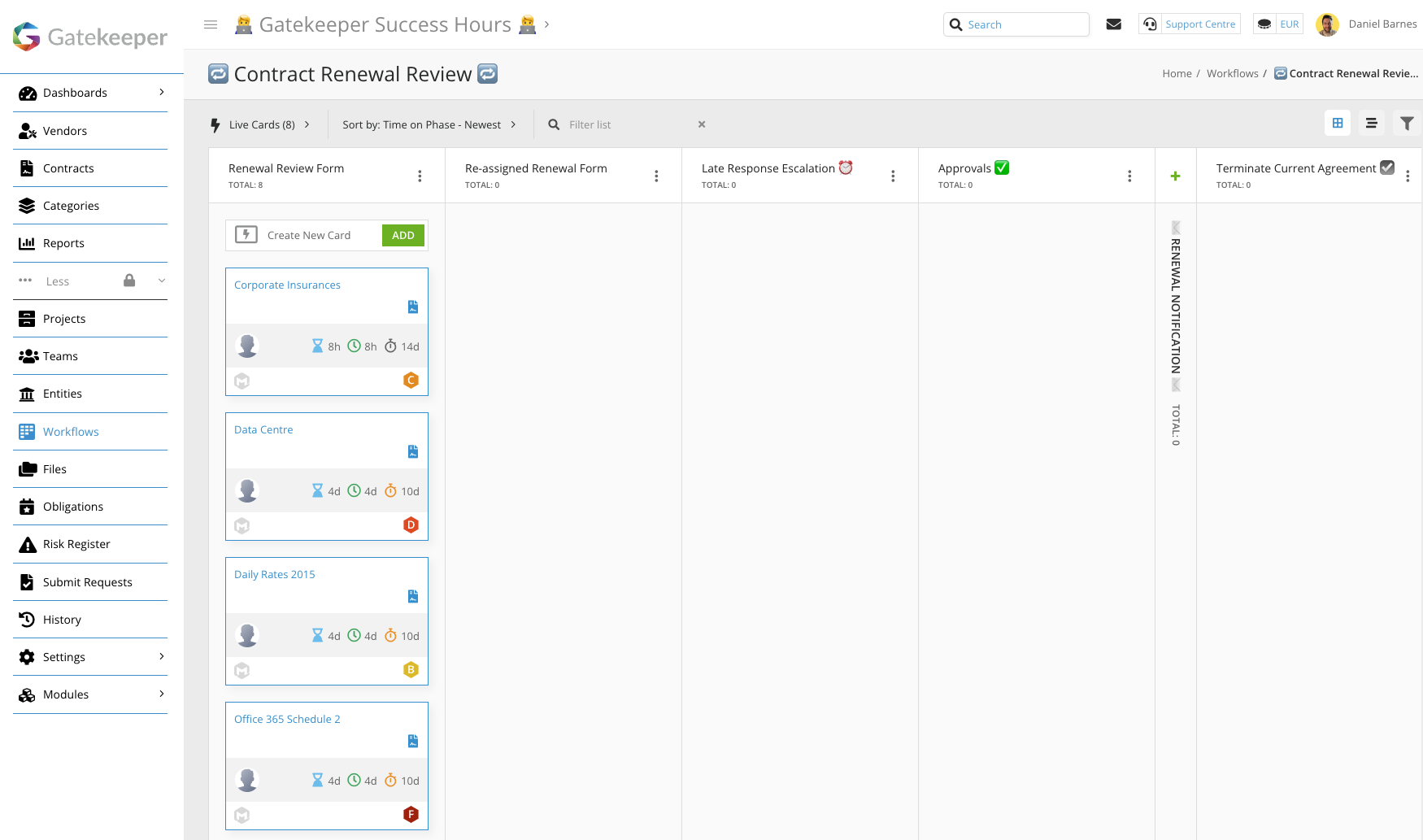Contract renewals were the bane of my life as a Contract Manager.
My fundamental issue was a lack of visibility as to when these renewals would happen.
Why?
Because in the dozen Excel trackers that organisations I've been part of use, we didn't always have all of the contract data, such as end dates and notice dates.
Whoever was responsible for a specific contract almost always forgot about the notice period date that was in place for auto-renewals or extensions.
It got more manic when teams within the Procurement function would keep a tracker document - even down to the individual having their tracker, which they would then duplicate into a team tracker.
The collection of tracker documents, each its own master tracker, made its way into a master tracker that the most senior people used to "plan stuff".
That's a recipe for disaster.
As you can expect - my colleagues would be letting me know last minute that the contract was approaching its end date and we needed to renew, but we should review it first.
Or I had to tell them - you've missed the notice period date, so we're locked in.
Then there were the comical situations.
The contract had ended months ago - even years ago. But everyone was getting on with the work like this had never ended. The vendor kept charging - often providing a massively reduced service.
These were the scenarios I spent my time fixing while working in Commercial and Procurement Teams
This pain of having a frantic, unofficial contract renewal process - or at times, a complete lack of process - led me to start creating a more formalised way of working in these organisations.
Over the last seven years of working in Procurement and Contract Management, this issue has raised its head many times.
Creating a contract renewal strategy that enables proactive contract management without renewals occurring outside of the budget is essential to your overall business aims.
Contract renewals can be a point where your team can create leverage with the vendor.
Due to the minimal contract management undertaken, I wondered about the value left on the table for some of these renewals.
So let us explore contract renewals to ensure we're maximising this opportunity.
What is a Contract Renewal?
Most contracts are put in place for a particular amount of time, referred to as the term.
In each of your contracts, you will have either a Contract End Date specified or a term that can be added to the Contract Start Date to derive the End Date.
The End Date is the last day of contractual obligations by both parties, outside of those that may exist beyond the End Date or contract termination.
Terms beyond this period usually relate to intellectual property, confidentiality, and non-solicitation, which in plain language means not stealing each other's staff.
Contract renewals give you the opportunity to:
- Determine if a continuing need for the contract exists
- Renegotiate any term in the contract
- Extend the term of the contract through the creation of a new contract
- Cover any performance issues from the current contract term
- Adjust the scope of the contract if mutually acceptable
Types of Contract Renewal
Contract renewals are simple when you break them down.
Mutual Renewal
These agreements have no renewal clause in them and will end at the end date.
To continue this contract, you must ensure that your organisation wants to continue working with this vendor. And you'll need to ensure that the vendor wants to continue working with you.
You'll likely agree to the same terms, albeit with minor changes.
However, nothing can stop you both from agreeing to a new set of Contract Terms, so you'll need to run this agreement through your Contract Review process if that happens.
Automatic Renewals
These agreements have a clause that states that the contract will renew if you do not serve notice to stop the auto-renewal X number of days before the contract end date.
On one-year terms, this notice date is usually 30-60 days before the contract end date. On longer-term agreements, it can be anywhere from 30-120 days.
You must work from the notice period date and not the end date.
You will want to capture that this agreement auto-renews so that you can pull reports to stay on top of this.
Contract Extension
Slightly different to a contract renewal, a contract may have a clause that states the contract can extend for a defined period of years.
The Procurement Team has likely agreed to set pricing during the original negotiations.
The advantage to taking up these contracts is that you pre-bake the negotiation at the very start. Typically, you secure better pricing based on the macroeconomic climate at the time of negotiation (this can work against you too).
Requirements you have on Termination
You may need to return assets to your vendor whenever you terminate an agreement. Or vice-versa.
This could be documentation, IP, loaned items or anything they sent you as part of the contract.
You must make sure you do this.
The consequences are usually a breach of contract with pre-baked damages in the contract.
How to Create your Contract Renewal Strategy
When creating a contract renewal strategy, you need to have three considerations top of mind:
- How will our colleagues interact with Procurement and Contract Management?
- What types of vendors and contracts do we prioritise?
- How can we make this process efficient?
1. How will our colleagues interact with Procurement and Contract Management?
We need to ensure that contract renewals get the contract owners involved.
These are our colleagues who own the day-to-day vendor relationship.
If they have to go through some long, convoluted process, this won't work.
Additionally, they must be aware of their requirements as a contract owner.
We must consider who needs to be part of each renewal's review and approval process.
This might mean we include the CFO on all renewals above a set value. We must make the process easy for everyone to use, review and approve.
 Use a Best Practice Workflow for your Contract Renewals within Gatekeeper
Use a Best Practice Workflow for your Contract Renewals within Gatekeeper
2. What types of Vendors and Contracts do we prioritise?
Focus on your strategic and important vendors when you get started.
You want to ensure that your vendors are segmented to show their level of importance.
Suppose you combine the vendor's segmentation with their category and contract type. In that case, you can set up different rules for each scenario.
For example, a strategic vendor delivering SaaS must have a Contract Renewal Review at least 100 days before the contract notice date.
Additionally, auto-renewals of contracts under a set spend value are acceptable without any further reviews - so long as you get confirmation the owner wants to continue the service with the vendor.
This could be a better use of time and resources, and the frictionless aspect of the renewal will be a value-add to your organisation.
Keep in mind that if you build this out digitally that prioritisation becomes less of a resource drain as the digitalised process will do most of the work.
3. How can we make this process efficient?
Suppose you plan on managing your contract renewals through a tracker spreadsheet.
In that case, you will fail to manage every renewal in compliance with your strategy.
I covered this at the article's start, but it's worth repeating here.
Managing your vendor and contract base through spreadsheets doesn't empower your contract owners either.
Everything becomes clunky and requires another email, call, or slack message that again breaks up your concentration.
It would be best if you used a Vendor and Contract Lifecycle Management solution, like Gatekeeper, to automate the start of your renewals.
Gatekeeper can issue notifications to the contract owner and captures all requests, negotiations and new contract data in one place.
It does this via the Contract Renewal Workflow, built within the Workflow Engine.
This is where you can digitalise all your vendor and contract processes. You can automate parts of the process, create rules, and get insights that would not be possible in a spreadsheet.
We've even built one that our customers can use with some basic configuration as part of our Best Practice Workflows.
Action Point for Contract Renewals: Consider these three points and create a 1-page document outlining your Contract Renewal Approach. Ensure you have a Contract Renewal Process and add it to this document.
How to Build your Contract Renewal Process
To have an effective Contract Renewal Process, we need three fundamental principles in place:
- Visibility of our contract and vendor base
- Control of our contracts and vendors through digitalised processes
- Provable compliance to our contract renewal strategy
Here's how to achieve this.
Create a Contract and Vendor Repository
Creating a contract and vendor repository is something almost every Procurement and Contracts team has done.
Typically, the first iteration of this is an Excel Tracker that you use to note the critical metadata for the vendor and their contracts.
We all know these Excel Trackers work until they don't.
What happens is that your team gets spread thinner. Admin, such as data entry, becomes the last task that any Procurement or Contact Professional wants to complete, and the tracker falls into disarray.
All of that work to create a central source of truth fails. And it will always be destined to fail.
Instead, you want to create a digital record that combines digitalised procurement and contract processes to extract data automatically.
No more completing spreadsheets.
So the first task is to create a truly digital vendor and contract repository.
These records will house your critical data, such as End and Notice Dates of the Contract, Contract Obligations, vendor Segmentation and more.
Now that we have restored the visibility of our contract and vendor data, we can move on to digitalising how we manage our Contract Renewals.
Create the digital Contract Renewal Process
Creating a contract renewal process is incredibly simple once we have that data.
I kid you not; it took me less than an hour to set up a contract renewal workflow when I was a user of Gatekeeper.
And we have an incredible Best Practice Workflow that can get you up and running fast.
You need to choose who the notification goes to when a contract is up for renewal.
For me, this must be the service or goods user.
We can ask them whatever we want, but keeping it simple, we could ask:
"Do you still want to use this vendor for this service?"
If they select yes, it moves to a review or approval phase.
If no, we move it to a termination phase.
You will have built the yes/no element into the digital process, which automates compliance with your contract renewal strategy.
And all of this was triggered by either the Notice Period Date or the Contract End Date, depending on what was more applicable.
 Set your contract renewal strategy up quickly with Gatekeeper
Set your contract renewal strategy up quickly with Gatekeeper
We could make this more specific and give us more time on Strategic Vendors in the SaaS category.
We're relying on our contact and vendor records data to make this easy for us, which you've captured in your digitalised vendor onboarding and contract renewal process.
Now we will never miss another renewal again.
Safeguard Compliance via Digitalised Contract Renewals
The Audit Trail - those external auditors love to talk about these.
We have a complete audit trail of all decision-making linked to this specific vendor contract regarding the renewal.
As mentioned above, you may have included your CFO as a reviewer.
When they review the renewal offer in Gatekeeper, they can leave a comment with either their rejection or approval to indicate why they've made that decision.
Before making that final decision, they can communicate with anyone in the business within Gatekeeper.
Once the renewal is complete, which could mean it has been renewed or terminated, we will always have a record of the entire decision-making process linked to the vendor and this contract.'
I know, from personal experience, that those auditors absolutely love this.
Whilst we're on the matter of safeguarding compliance, the successful implementation of your contract renewal strategy should include third-party checks.
I'd recommend keeping up-to-date finance and cyber checks against your vendors and their software services.
That way, when your CFO reviews the renewal request, they have increased confidence that this is a good deal for your company.
In Summary
A digitalised contract renewal process can save your business money, improve collaboration ahead of key dates and help you to negotiate from a stronger position.
If you like the idea of digitalising your contract renewal process, please book a demo to get you started on your digital vendor and contract journey.

.png)
.png)
.png)
-4.png)